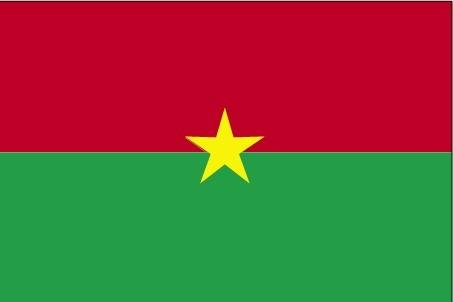181 Burkina Faso

Two equal horizontal bands of red (top) and green with a yellow five-pointed star in the center. Red recalls the country’s struggle for independence, green is for hope and abundance, and yellow represents the country’s mineral wealth.
Flag courtesy of the CIA World Factbook

Map courtesy of the CIA World Factbook

The railway station in Bobo Dioulasso was built during the colonial era and remains in operation.
Government
According to Britannica, Burkina Faso’s constitution was adopted by referendum in 1991 and has since been amended. It allows for multiparty elections and a parliamentary republic with a president as chief of state and a prime minister, who is appointed by the president, as the head of the government. The president is elected by popular vote for a five-year term and may serve up to two consecutive terms. The legislative branch of the government is represented by the National Assembly, whose members are elected by universal suffrage for five-year terms. In 2014 popular unrest led to the dissolution of the government in October, followed by the establishment of a transitional administration in November. It was succeeded by a democratically elected government that commenced with the inauguration of a new president and a new National Assembly in late December 2015 and a new prime minister in January 2016. A military coup in January 2022 deposed the president, suspended the constitution, and dissolved the National Assembly and the government.
Burkina Faso is divided into régions, which in turn are divided into provinces, which are further divided into départements. Each région is administered by a governor, and each province is administered by a high commissioner.
National Civil Aviation Agency (ANACBF)
The National Civil Aviation Agency of Burkina (ANAC BF) is an independent administrative institution with legal personality, financial and management autonomy. Created in 2009 by decree n°2009-940/PRES/PM/MEF/MT of December 31, 2009, it will undergo a change at the end of decree N°2015-788/PRES-TRANS/PM/MIDT/MEF of 02 July 2015 amending its powers, organization and operation.
Airspace
SkyVector – Google Maps – ADS-B Exchange
ICAO countries publish an Aeronautical Information Publication (AIP). This document is divided into three parts: General (GEN), En Route (ENR) and Aerodromes (AD). ENR 1.4 details the types of airspace classes they chose to adopt from classes A through G.
Drone Regulations
Advanced Air Mobility (AAM) Regulations & Policies
None found by the author.
However, should you, the reader, happen to stumble across something to the contrary, please email the author at FISHE5CA@erau.edu and you may be mentioned in the ACKNOWLEDGEMENTS section of this book by way of thanks for contributing to this free eBook!
Advanced Air Mobility (AAM) News
None found by the author.
However, should you, the reader, happen to stumble across something to the contrary, please email the author at FISHE5CA@erau.edu and you may be mentioned in the ACKNOWLEDGEMENTS section of this book by way of thanks for contributing to this free eBook!
Short Essay Questions
Scenario-Based Question
You have been hired by a Drone Startup Company. Your boss has immediately assigned this job to you.
They need you to prepare a one-page memo detailing the legalities of using a drone to film the railway station, pictured above.
They need you to mention any national laws and local ordinances.
They specifically want to know what airspace (insert pictures) you will be operating in and whether or not you need an airspace authorization.
Does it matter whether or not you are a citizen of the country?
Lastly, there is a bonus for you if, as you scroll through this chapter, you find any typos or broken links!
Short Essay Questions
- What are the drone categories?
- How is registration addressed?
- How is remote ID addressed?
- What are the model aircraft rules?
- What are the commercial drone rules?
- Are there waivers or exemptions to the rules? If so, for what?
- Would you share a link to an interactive airspace map?
- How is BVLOS addressed?
- How can you fly drones at night?
- How can you fly drones over people?
- Where do you find drone NOTAMs?
- What are the rules for drone maintenance?
- What are the rules for an SMS program?
- What are some unique rules not mentioned above?
- What are the C-UAS rules?
- What are the AAM rules?

